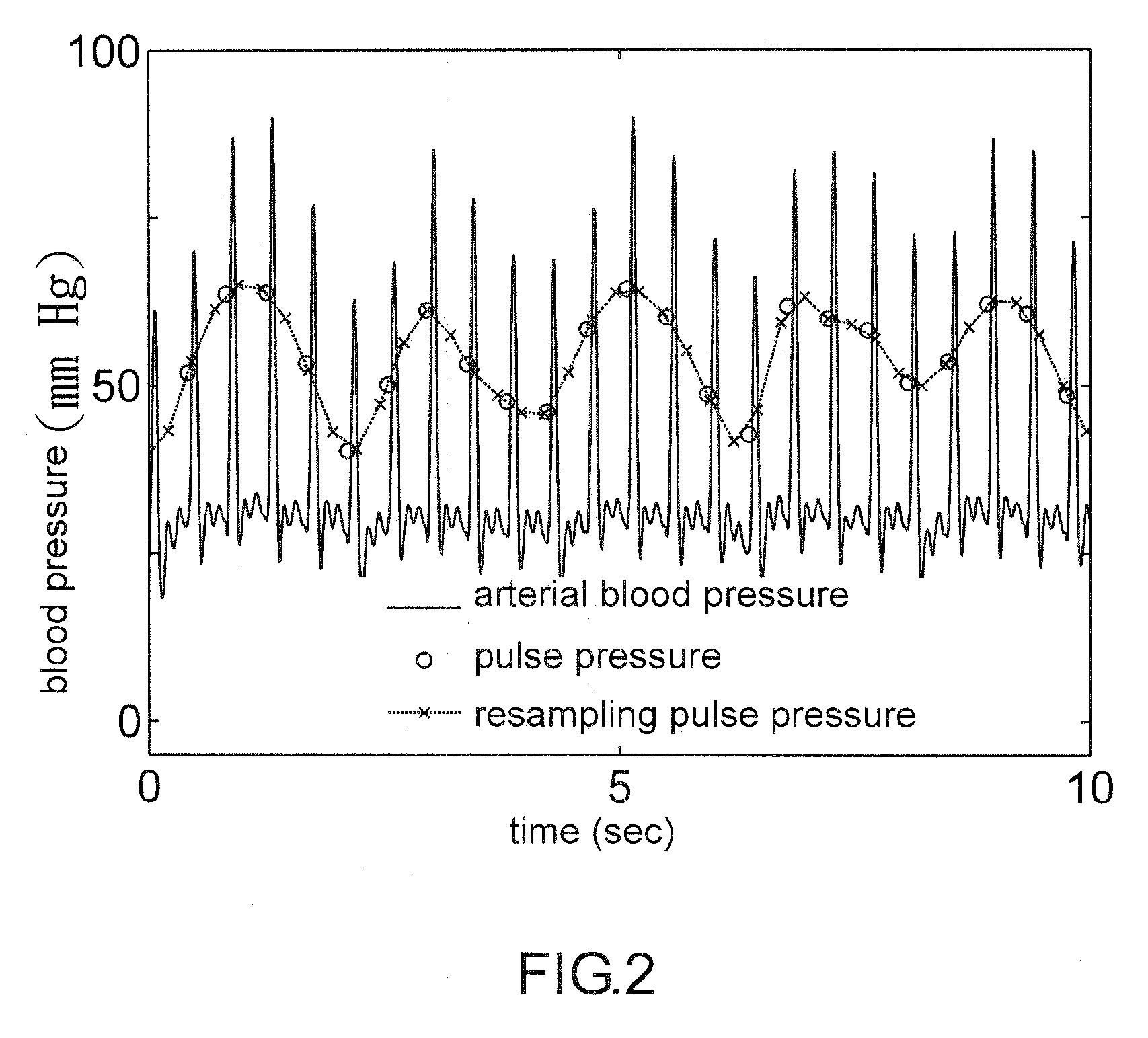Spectrum analytical method for quantifying heat-lung interaction
a technology of heat-lung and analytical methods, applied in medical science, diagnostics, angiography, etc., can solve the problems of affecting the variation of the stroke volume of the left ventricle on the next heartbeat, and the blood volume injected into the pulmonary arteries will be reduced, so as to achieve the effect of reducing the stroke volume and increasing the stroke volum
- Summary
- Abstract
- Description
- Claims
- Application Information
AI Technical Summary
Benefits of technology
Problems solved by technology
Method used
Image
Examples
first embodiment
[0037]In the present invention, the spectrum analytical method for quantifying heart-lung interaction is used in monitoring of arterial blood pressure. The arterial blood pressure is measured by a conventional device for monitoring cardiopulmonary volume or any other devices for monitoring arterial blood pressure.
[0038]First, arterial blood pressure signals in a time domain are obtained by using a device for monitoring arterial blood pressure, then the arterial blood pressure signals are transformed to pulse pressure (PP) signals by normalization according to the following equation (1):
PPnorm=(PP−PPmean) / PPmean (1)
wherein
PPnorm is a normalized pulse pressure signal,
PP is an arterial blood pressure signal,
PPmean is a mean value of arterial blood pressure signals within the time domain.
In order to obtain sufficient arterial blood pressure signals for analysis, there are 2 or more, preferably 10 or more, respiratory cycles in the time domain. The measuring time is about 1 minute or mo...
second embodiment
[0048]In the present invention, the spectrum analytical method for quantifying heart-lung interaction is based on monitoring of blood flow. The blood flow is measured by a conventional infrared plethysmography monitoring device or any other device suitable for monitoring blood flow. The infrared plethysmography monitoring device monitors blood flow by measuring the absorption of infrared light by hemoglobin.
[0049]As stated before, first, blood flow signals in a time domain are taken, then transformed to blood flow difference signals by normalization according to the following equation (3):
BFnorm=(BF−BFmean) / BFmean (3)
wherein
BFnorm is a normalized blood flow difference signal,
BF is a blood flow signal,
BFmean is a mean value of the blood flow signals within the time domain.
In order to obtain sufficient blood flow signals for analysis, there are 2 or more, preferably 10 or more, respiratory cycles in the time domain. The measuring time is about 1 minute or more.
[0050]Reference is made...
third embodiment
[0054]In the present invention, the spectrum analytical method for quantifying heart-lung interaction is based on monitoring of blood flow velocity. The blood flow velocity can be obtained by measuring the potential difference between the two electrodes when blood flows through these two electrodes, or measured by a Doppler ultrasound device or any other device suitable for monitoring blood flow velocity. Through the above method, blood flow velocity can be non-invasively measured without contacting blood. The Doppler ultrasound device is used to monitoring the blood flow velocity in femoral arteries.
[0055]As stated above, blood flow velocity signals in a time domain are taken and then transformed to blood flow velocity difference signals by normalization according to the following equation (4):
BFVnorm=(BFV−BFVmean) / BFVmean
wherein
BFVnorm is a normalized blood flow velocity difference signal,
BFV is a blood flow velocity signal,
BFVmean is a mean value of blood flow velocity signals w...
PUM
 Login to View More
Login to View More Abstract
Description
Claims
Application Information
 Login to View More
Login to View More - R&D
- Intellectual Property
- Life Sciences
- Materials
- Tech Scout
- Unparalleled Data Quality
- Higher Quality Content
- 60% Fewer Hallucinations
Browse by: Latest US Patents, China's latest patents, Technical Efficacy Thesaurus, Application Domain, Technology Topic, Popular Technical Reports.
© 2025 PatSnap. All rights reserved.Legal|Privacy policy|Modern Slavery Act Transparency Statement|Sitemap|About US| Contact US: help@patsnap.com



